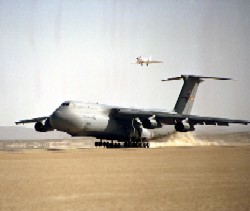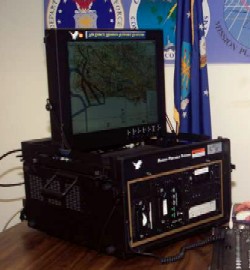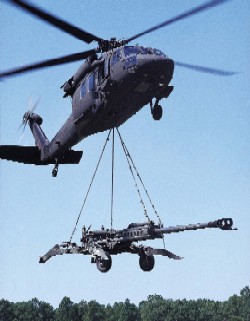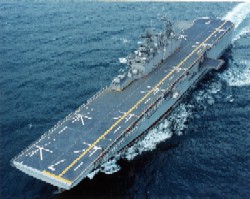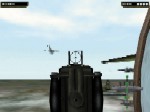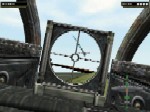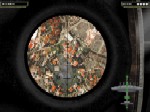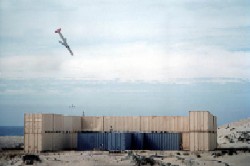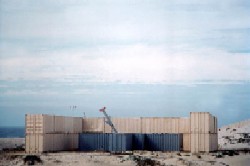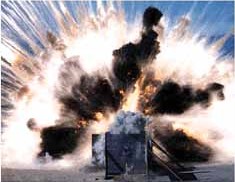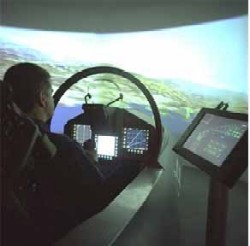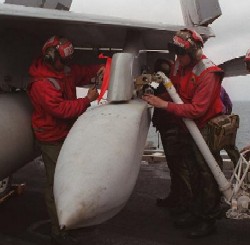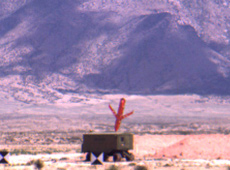Page 1
Daily News
By Gail Helmer
| Send Us News | Archives | Main |
Friday, May 4, 2001
PC News
- IL-2 Sturmovik Development Update
- 767 Pilot in Command Patch 1.1
- Aircrew Skill Credited With Safe Landing Of Crippled C-5
- ESC Upgrades U-2 Mission Planning Software
- Sikorsky, US Army Sign Black Hawk Upgrade Contract
- US Army Future Needs Rapid Insertion Capability
IL-2 Sturmovik Development Update
This weeks update, from Oleg Maddox, includes screenshots of various AI aircraft in the final release. Click here for this weeks update.
767 Pilot in Command Patch 1.1
Wilco Publishing has released an update for 767 Pilot in Command, its add-on to Microsoft Flight Simulator. In addition to the usual fine-tuning and bug repairs, the 1.9 MB update adds the option to plot a fixed position between waypoints on a flight plan, a new “rising runway” display that appears on the EADI whenever you’re landing your craft, broader control over the occurrence of random failures, and a variety of other modifications. Click here to download the patch.
The new FIX page on the Flight Management Computer makes it possible to create more complex flight plans by determining where a particular FIX is in relation to the aircraft or flight route. Once the desired FIX is entered, the page displays the bearing and distance from the aircraft’s present position as well as the estimated time of arrival, distance to go, and predicted altitude upon reaching the point where the bearing or distance line intersects with the active route.
The new rising runway symbol on the EADI appears whenever the aircraft is below 2500 feet radio height, moving progressively closer to the aircraft symbol as it nears the ground to give a visual 3D indicator of the aircraft’s relative position to the runway vertically and laterally. This display, which is available on some real 767s but not all, is particularly helpful when making low visibility approaches.
Random failures, part of an extensive series of simulated emergencies provided in 767 Pilot in Command, can now be selected to occur on a per-hour, per-day or per-month basis. The failure rate in the given time period can also be specified, and failures can be selected from among specific categories or all types of malfunctions. These range from tire blowouts, locked gears and windshear to electrical failure, cabin depressurization and engine trouble.
Military News
Aircrew Skill Credited With Safe Landing Of Crippled C-5
Skillful flying and the ideal surface of Edwards'Rogers Dry Lake averted a potential disaster May 2 as the crew of a C-5 Galaxy brought its disabled aircraft to a safe landing on the lakebed here. After landing without the front landing gear, the eight crew members and nine passengers walked away uninjured. While maintenance personnel continue to examine the aircraft, the Galaxy seems to have sustained little damage.
The massive cargo plane from Travis Air Force Base, Calif., was enroute to Colorado Springs, Colo. on the first leg of a long-distance supply mission when the crew discovered the nose landing gear door was stuck, preventing the landing gear from going down. "We realized immediately something was wrong," said aircraft commander Maj. Greg Lloyd, a reservist with the 301st Airlift Squadron at Travis.
The crew, comprising both Reserve and active duty crewmen returned to Travis AFB and considered landing there before abandoning the idea. "We were just turning circles there," Lloyd said. "We tried every trick in the book, as well as some that weren't in the book, but (the gear) just wasn't going to (extend)." However, Lloyd said he and fellow pilot Maj. Scott Paffenroth, also with the 301st AS, were thinking Edwards from the start. "The first thing out of our mouths was, 'if we've got to land this thing, let's go to that big beautiful lakebed at Edwards,'" he said.
Among the largest aircraft in the world, the Galaxy demands long, sturdy runways in the best of flying conditions. Without landing gear, the momentum of the large airframe makes it very difficult to control. To Lloyd, having the lakebed available was a huge confidence booster for the crew.
"We had options," he said. "We could have landed at Beale (AFB, Calif.), but the downside is that their runway is concrete and asphalt. You're talking about very little room for error there. With that lakebed, you can just let the momentum (of the aircraft) grind itself to a halt."
For the nine passengers on board, the experience was jarring, but they never doubted their safe landing. "The pilot was calm, cool," said Tony Abrazado from San Diego. He knew his business. He said this was something he could handle, so we never worried." In fact, most of the passengers could not believe how smooth the landing actually was.
"To be honest," said Edward Horne, also from San Diego, "I didn't really believe we had actually landed without our landing gear,it was so soft; at least, not until we got off the plane and saw it." Lloyd agreed the landing went as well as they could have expected. "It worked great," he said. "The crew worked really well together to make this happen." All the same, it's not an experience he wants to repeat. "It's definitely not something you look forward to," he said. "But it's an opportunity to do our job. This is what we train for."
According to Col. Robert Hood, Air Force Flight Test Center vice commander, the emergency landing was just the latest example of the immense value of the 44-square-mile lakebed. "Edwards' lakebeds have always been a godsend for our aircrews," he said. "There's just no telling how many tragedies those lakebeds have avoided."
Aviators have relied on the smooth, hard surface of Rogers -- as well as its smaller neighbor, Rosamond Dry Lake -- since the early '30s as ideal emergency landing sites. Since the dawn of the jet age in the mid-40s, the lakebeds made Edwards an ideal location for flight testing, and Hood credits the natural runways with saving hundreds of lives and millions of dollars worth of equipment.(Courtesy photo)
ESC Upgrades U-2 Mission Planning Software
A new computer and automated software that allows U-2 reconnaissance aircraft flight crews to more effectively set up their missions will be installed and tested this month. The installation and testing of the component is being managed by the U-2 Integration Branch at the Combat Air Forces Command and Control Systems Program Office here. The U-2 mission includes collecting multi-sensor photo, electro-optic, infrared and radar imagery as well as performing other types of reconnaissance functions.
"These hardware and software updates represent dramatic performance improvements," said Lt. Col. Christopher King, Air Force mission support system and mission planning system program manager at Electronic Systems Center. "The Mission Planning System V (five) computer, running the latest mission planning software, operates at approximately 19 times the speed of systems used in 1995."
To use the system, the navigator receives mission information which includes route and collection (radar and electro optical sensor) plans. The navigator then completes the plan using the software and creates a data transfer disk. The disk allows the mission to be loaded onto the aircraft's flight computer via a portable data transfer system.
The MPS-V also creates the required in-flight hardcopy products including charts and documents used by the U-2 pilot to perform the mission. "With the MPS-V, I can plan an entire U-2 mission in one quarter of the time it used to take with the older systems, including mission upload to the aircraft," said Maj. Rick Laughman, officer in charge of U-2 software operations and evaluation at Beale Air Force Base, Calif.
Using software modules, the new software integrates U-2 common sensor planner and aircraft/weapon/electronics software with other mission planning requirements. The AWE module is used to create the initial route of flight and to enter aircraft specific information into the mission plan.
On any particular mission, the U-2 may have 400 to 500 different requests for data collection using the array of equipment onboard. Each sensor has limitations such as camera range and distance, cloud cover, sun or moonlight shadows and other factors. The CSP takes these limitations into consideration and uses the route created by the AWE to plan when and where along the route sensors will turn on or off to collect the images or signals that have been requested for that particular mission.
"Integration of these modules has been a complex interface management task," said Dennis Huggler lead for U-2 mission planning at the U-2 management directorate at Robins AFB, Ga. "We knew from the start that these software packages had to speak to each other and we opened the communication channels early in the software development process," Huggler said. "The results show the extraordinary dedication between all involved to share and communicate information."
The entire MPS-V unit fits into a protective transit case and weighs about 70 pounds. MPS systems purchased in the early '90s were packaged into 13 large transit cases and required two shipping pallets for deployment. The Unix-based MPS-V features a 440 megahertz processor module, 512 megabytes of RAM, and 4 hard drives totaling 118 gigabytes. It is also the first MPS to use a 20-inch flat panel liquid crystal display color monitor.(Courtesy photo)
Sikorsky, US Army Sign Black Hawk Upgrade Contract
Sikorsky Aircraft Corporation has signed a $219.7 million research, development, test and evaluation (RDT&E) contract with the US Army that begins the UH-60M BLACK HAWK helicopter upgrade programme. Ultimately the programme will involve the modernisation of as many as 1,200 aircraft during the next 25 years. Beginning this year, Sikorsky will make four RTD&E UH-60M test articles, three converted from existing UH-60 BLACK HAWK aircraft and one built off the production line. Work on the first 12 low rate initial production (LRIP) UH-60M aircraft will begin in 2004. The follow-on lot will be 18 aircraft, and the programme will reach its stride with the induction of 60 aircraft a year by 2006.
The UH-60M programme will extend the UH-60 production for another 20-25 years. The current Army Aviation Modernisation Plan projects no replacement for the BLACK HAWK to enter service prior to 2025. "This programme will marry the latest technology to a venerable battle-tested machine," said Dean Borgman, president of Sikorsky.
The configuration being developed will modernise the design by providing digital avionics and flight controls, a graphite main rotor blade, a strengthened fuselage, and standardising many other improvements introduced since production began. These changes are designed to increase BLACK HAWK payload by up to 2,000 pounds and aircraft speed by up to 15 knots. Maintenance costs for the M-model could be 25 percent lower than for original A-model BLACK HAWKs.
The Defence Acquisition Board in March approved entry into Milestone B, System Development and Demonstration for the recapitalisation/upgrade programme to improve the US Army's BLACK HAWK fleet. Sikorsky began UH-60A BLACK HAWK production deliveries in 1978, making the oldest aircraft more than 23 years old. The current production BLACK HAWK is the more powerful UH-60L, which entered service in 1989.
The Army has defined a requirement to increase the payload and range of the older UH-60A fleet to carry heavier equipment acquired since the inception of the BLACK HAWK programme and to meet its emerging doctrinal needs, including operating on the digital battlefield.
The UH-60M will be fielded in the 2006 time frame and feature wide chord composite spar main rotor blades, a digitised 1553 bus-based cockpit and avionics suite, an advanced flight control computer, a strengthened fuselage and advanced infrared suppression. The UH-60M will standardise the current fleet with the UH-60L General Electric T700-GE-701C engine and the improved durability main gearbox. The UH-60M will be built both as a retrofit to the older UH-60A and UH-60L fleet and as a new aircraft under future multi-year H-60 production contracts.
US Army Future Needs Rapid Insertion Capability
If the US Army's future Objective Force is to be effectively employed more than a decade down the road, the force needs fast shallow-draft transports and aircraft that can carry at least one medium armoured vehicle with crew and then land it on a short airstrip. Those observations were made by officials conducting 'Vigilant Warriors,' a war game designed to refine emerging Army Transformation concepts at the US Army War College in Carlisle Barracks, Pa., April 23-26.
"It is important to bring a force that can affect the situation rapidly," said retired Brig. Gen. Huba Wass De Czege, the commander of the notional US-led international coalition known as the Blue Force. "We can't dribble forces into the theatre. It doesn't have impact unless you get there in mass." Getting there first doesn't mean much unless soldiers arrive with the equipment they need to deploy immediately, he said.
The Army Transformation answer to the issue of Confederate cavalry commander Nathan Bedford Forrest's axiom of "getting there the firstest with the mostest" is packaging troops, their equipment and ammunition for transport together, whether they go by air or sea, according to Brig. Gen. Hank Strattman, war game director. This will allow units to immediately affect operations when they arrive in a theatre of operations, he said.
The Gulf War demonstrated the need for packaging as many troops arrived in Saudi Arabia via commercial air and then had to wait up to two weeks before their vehicles and other heavy equipment arrived by sea -- unable to conduct any combat operations during the wait.
Besides allowing the Transformation concept of packaging to work more effectively, use of new shallow-draft transports and short-takeoff/landing cargo aircraft would also assist the concept of rapid entry into a theater, Strattman said.
Current military heavy sea and airlift capability requires the use of deep-sea ports and major airports. These ports are usually few enough in any area of the world to be high priority targets for conventional or unconventional attack by an opposing force with the goal of hindering or stopping the flow of men and material into the area, Strattman explained.
The envisioned shallow-draft transports would carry both men and equipment and be able to offload them along almost any coastline. The cargo aircraft would be able to use air strips of 1,000 feet or less. This would exponentially expand the number of places US forces can be quickly inserted for immediate operations, he said.
The Navy and Air Force are working toward giving the Army the transport capability it wants for the Objective Force. Like the Army, the two services are attempting their own transformations using Chairman of the Joint Chiefs of Staff Gen. Henry H. Shelton's Joint Vision 2020 as a guide. Part of the joint vision is improved strategic mobility.
Shortly after becoming the Army chief of staff almost two years ago, Gen. Eric K. Shinseki set the Army on the road to developing and fielding Interim Brigade Combat Teams to fill the deployability gap between today's Legacy Force and the Objective Force.
Using a medium armoured vehicle made by GM GDLS Defense Group L.L.C. as its backbone, the IBCTs will be able to deploy to a theatre of operations within 96 hours of notification and be able to stand up to an armoured threat more effectively than a light division, officials said.
Third Brigade, 2nd Infantry Division, stationed at Fort Lewis, Wash., is currently using a mix of medium to light armoured vehicles to develop IBCT tactics and doctrine until it gets the new vehicles later this year.
"We may not know right now exactly what the Objective Force will look like, but we have a good idea what we want it to do," Strattman said. "This exercise is all about refining what capabilities we want so that technology research can deliver."
Under the current timeline, two additional Transformation war games will refine and access desired Objective Force characteristics, concepts and capabilities before a decision is made on what that force will be in 2003. The first Objective Force unit may be fielded as early as 2013 with a fielding plan stretching out to 2035 or beyond before all Legacy and Interim Force units are replaced, Anderson said.
Thursday, May 3, 2001
PC News
Interplay Announces SFC: Orion Pirates
Interplay has announced that Star Trek: Starfleet Command - Orion Pirates is currently in development. Starfleet Command - Orion Pirates is a stand-alone mission pack that adds a new storyline and significant new features to the Star Trek: Starfleet Command series and will allow gamers the unique experience of playing as the ruthless Orion Pirates for the first time. Starfleet Command - Orion Pirates is scheduled for release in Q2, 2001. Click here to visit the website.
Wednesday, May 2, 2001
PC News
- Strategy First Announces E3 Lineup
- Novalogic Announces New President
- Pilot Error Caused Bombing Deaths At Kuwaiti Range
- Army Refuse To Wear Chinese-made Berets
- U.S. Navy Announces Design and Construction of LHD 8
- Cold War Deterrents 'No Longer Enough,' Bush Says
Strategy First Announces E3 Lineup
Among the titles being shown at this year's Expo are; O.R.B., a 3D real-time space strategy game that is said to rival Homeworld; Disciples II: Dark Prophecy, the highly anticipated sequel to the award-winning Disciples: Sacred Lands; Nexagon: The Pit, a new title that combines raw action and power with strategy and tactics; Zero-G Marines, a first person squad based shooter that takes the genre to new heights in the void of space; Rails Across America, the new real-time rail strategy game developed by Flying Lab Software (ex-members of EA, Sierra and Microsoft); Empire of the Ants, a real-time strategy game from Microides that brings the popularity of Antz™ and A Bug's Life™ to the computer screen, AND World War II Online - the first massively multiplayer online game from Cornered Rat Software/Playnet. WWII Online will make its first large public appearance at E3!
Novalogic Announces New President
Computer developer and publisher NovaLogic, Inc. has appointed Lee Milligan as its new President and Vice Chairman of the Board of Directors. The promotion is effective immediately. Milligan joined the NovaLogic team eight years ago as Chief Financial Officer. In 1995 he was named Chief Operating Officer and appointed a member of the Board of Directors and Corporate Secretary. Milligan will continue to serve in the roles of COO and CFO in addition to his new duties.
"We are thrilled to have Lee Milligan take on his new responsibilities at such an exciting time for the company," said John Garcia, who has served as President of NovaLogic for 15 years and will continue in his roles as Chief Executive Officer and Chairman of the Board. "We will benefit from his experience, dedication and leadership."
Military News
Pilot Error Caused Bombing Deaths At Kuwaiti Range
U.S. Central Command officials have determined pilot error was the main cause of the deadly March 12 bombing accident at Kuwait's Udairi Range. A Navy F/A-18 Hornet pilot incorrectly identified an observation post as his target and dropped three 500-pound bombs that killed five Americans and a New Zealander and injured 11 others. Six Kuwaiti service members were among the injured.
Immediately after the accident, Army Gen. Tommy R. Franks, CENTCOM commander in chief, appointed Marine Lt. Gen. Michael P. DeLong to lead an investigation. DeLong's team reported their findings to Franks April 7. Franks accepted the board's findings April 23 with a few minor changes regarding possible punishment of key individuals. Release of the results was delayed until the families of those killed were apprised of the findings.
The report identifies pilot error as the main cause of the accident, but with three contributing factors:
According to the report, the pilot, Cmdr. David O. Zimmerman, was required to transmit, "Target in sight; friendlies in sight," before he'd have received a "cleared hot" command freeing him to drop his bombs. He apparently never made that call and released his ordnance before being given the "cleared hot" command, the report states.
- The forward air controller airborne pilot used nonstandard terminology when speaking to the pilot on the bombing run.
- The ground forward air controller lost situational awareness at a critical point, reducing the time he had to call for an "abort" of the mission.
- Conditions at Udairi Range made the observation post and the target difficult to distinguish.
Zimmerman told the board he was "deeply saddened" by the accident but declined to be interviewed on the advice of legal counsel, the report stated.
The forward air controller airborne pilot, Navy Lt. Patrick T. Mowles, contributed to the accident by telling Zimmerman, "good nose position," not a standard transmission for this type of mission.
"This resulted in a 'warm fuzzy' (false situational awareness) by the [ground forward air controller] and may have resulted in a 'warm fuzzy' by the incident pilot during his attack," the report states.
The forward air controller airborne radar intercept officer, Navy Lt. Andrea M. Powers, provided information to the board when she was ordered to testify under a grant of immunity, according to the report.
Prior to releasing his bombs, Zimmerman had asked to have the target illuminated. This allegedly caused the ground forward air controller, Air Force Staff Sgt. Timothy B. Crusing, to turn his attention to the individual on the ground whose job it was to illuminate the target with an infrared pointer. This diversion of his attention delayed his noticing the pilot had targeted the observation post.
When he did notice, he immediately transmitted, "Abort, abort." But the bombs had already been released and exploded seconds later. Crusing was seriously injured and was evacuated to Landstuhl Regional Medical Center in Germany and later to Walter Reed Army Medical Center in Washington. Investigators interviewed him by telephone from Walter Reed.
The report also noted that range personnel were not required to wear protective vests or helmets at Udairi Range. The investigation determined use of these devices could have potentially protected those killed and injured and recommended they be used at the range from now on.
After studying the report, Franks left the final decision regarding possible punishment of those involved up to the Central Command component commanders of the individuals. The board's report recommended "appropriate administrative or disciplinary action up to and including nonjudicial punishment" be taken against the pilot and that "appropriate administrative action" be taken against the other two involved.
"My modification does not in any way reflect my view as to what action may or may not be appropriate," Franks wrote in a memorandum to the component commanders. "It is intended to assure the appropriate service official of his or her complete discretion in the matter."
Franks agreed with the board's recommendation to improve the planning and coordination of live-fire exercises at Udairi Range. "While we must train as we fight, commanders understand that we must do everything we can to ensure that the training environment, while realistic, is as safe as it can possibly be," he wrote.
He gave the service commanders in the region 45 days to identify ways to make the range safer. "Our responsibility is to take the action necessary to preclude reoccurrence of such tragic accidents in the future," Franks wrote.
Army Refuse To Wear Chinese-made Berets
Not all soldiers will don black berets June 14, officials said, adding that a phased fielding of the headgear will continue into November.The delay in fielding some berets is due to three companies defaulting on their beret delivery, officials said, and a policy decision not to issue berets produced in China.
"The Army chief of staff has determined that U.S. troops shall not wear berets made in China or berets made with Chinese content," said Deputy Defense Secretary Paul Wolfowitz in a statement May 1. "Therefore, I direct the Army and the Defense Logistics Agency to take appropriate action to recall previously distributed berets and dispose of the stock."
An order for about 618,000 black berets had been contracted to a British firm, Kangol Limited, that subcontracted to produce the berets at a factory in China. About half of those berets have already been delivered, officials said, but most have not yet been issued to soldiers. Those berets will be recalled and sold as surplus through the Defense Reutilization and Marketing Office, according to a DLA spokesperson.
In addition, three contracts were canceled this week with U.S. companies that had beret factories in Romania, South Africa and India. "Quality was one of the issues," said a DLA spokesperson about terminating the contracts April 30. She added that the three companies had not met their delivery schedule.
Originally, 4.8 million berets were contracted to seven different companies for a total cost of $29.6 million, according to DLA.
Army Chief of Staff Gen. Eric K. Shinseki announced in October that soldiers would begin wearing black berets on the Army's birthday, June 14, as a symbol of the Army's transformation to a lighter, more-deployable force.
Soldiers in Ranger units, who have traditionally worn the black berets, will switch to tan berets. Soldiers in Airborne units will continue to wear the maroon berets, officials said, and Special Forces will continue to wear the green berets.
U.S. Navy Announces Design and Construction of LHD 8
The U.S. Navy has awarded an additional $196.5 million to Litton Ingalls Shipbuilding, a subsidiary of Northrop Grumman Corporation, for the continuation of work towards the construction of an eighth WASP (LHD 1) Class large-deck, multipurpose, amphibious assault ship.
Under the modified contract awarded today, Ingalls will purchase long lead material, develop planning for construction of the ship, begin technical manual development for major equipment, perform additional detail design work and procure shore-based spare equipment. The contract modification, in addition to the award today, includes options for later exercise by the Navy for fabricating early ship assemblies and procuring additional material and equipment. The additional value for these options is approximately $82 million.
Seven of the ships, designed to carry some 2,000 Marines to world trouble spots, have already been delivered to the Navy by Ingalls, with six of them active in the Fleet. IWO JIMA (LHD 7), delivered to the Navy on April 6, will be commissioned in Pensacola, Fla., on June 30. As the large-deck centerpiece of a Navy/Marine Corps Amphibious Ready Group, LHD's embark, transport, deploy, command and fully support a Marine Expeditionary Unit. The ships are fully capable of amphibious assault, advance force and special purpose operations, as well as noncombatant evacuation and other humanitarian missions. The ships are 844 feet long and displace 40,500 tons.
For operational support, the ship carries its own AV-8B Harrier II jets, and can carry Osprey (MV-22) tiltrotor aircraft, as well as a full range of Navy/Marine Corps helicopters, amphibious vehicles and tanks. Additionally, the ships are fully equipped with command and control (C 4 I) systems for flagship command duty. They also have medical facilities, including a 600-bed hospital, second only to the Navy's Hospital Ships in capability.(PRNewscom Photo)
Cold War Deterrents 'No Longer Enough,' Bush Says
President Bush provoked mixed reaction yesterday in a speech outlining his ideas for nuclear cuts and a post-cold war missile defence framework. Speaking in a televised appearance at the National Defence University in Washington, Bush said today's new world requires "new concepts of deterrence that rely on both offensive and defensive forces."
His speech may also be the death knell for the 1972 ABM Treaty signed by the US and the Soviet Union. The President said "we must move beyond the constraints of the 30 year old ABM Treaty. This treaty does not recognise the present, or point us to the future. It enshrines the past. No treaty that prevents us from addressing today's threats, that prohibits us from pursuing promising technology to defend ourselves, our friends and our allies is in our interests or in the interests of world peace."
President Bush referred to the growing number of countries with nuclear capabilities as the main argument for a missile defence system. "Unlike the Cold War, today's most urgent threat stems not from thousands of ballistic missiles in the Soviet hands, but from a small number of missiles in the hands of these states, states for whom terror and blackmail are a way of life."
The president said that he is committed to achieving a "credible deterrent with the lowest possible number of nuclear weapons consistent with our national security needs, including our obligations to our allies." He said that he will "move quickly" to reduce nuclear forces and the United States "will lead by example, to achieve our interests and the interests for peace in the world." Bush said he would dispatch "high level representatives" to allied capitals in Europe, Asia, Australia and Canada "to discuss our common responsibility to create a new framework for security and stability that reflects the world of today."
The delegations, to begin leaving next week [May 6-12], will be headed by Richard Armitage, deputy secretary of state; Paul Wolfowitz, deputy secretary of defence, and Steve Hadley, deputy national security advisor.
Unsurprisingly, global response to the speech was mixed. While there was cautious welcome for Mr. Bush's plans to initiate discussions regarding future proposals for the unilateral disarming of nuclear weapons, his comments on the ABM treaty provoked criticism.
"If the United States actually goes through with its intention to abandon the 1972 treaty, that would destroy the entire security system we have today," Dmitry Rogozin, head of the parliamentary foreign affairs committee in the Duma, told Interfax news agency.
He warned that Russia could even go through with a threat to give up the START-2 strategic arms reduction treaty if the United States violated the ABM accord.
The Chines state news agency Xinhua, which usually reflects the official Government line, was equally critical, saying, "...the US plan to build a missile defense system will not only spark a new arms race and create a proliferation of weapons of mass destruction, but will also threaten world peace and security in the 21st century."
Of Bush's allies, both Britain and Australia voiced support for the President's intentions but these were tempered by the concerns of most countries not to upset the delicate global balance that exists with regard to nuclear issues.
Australia's government said it would allow the United States to use joint military bases in Australia for the planned missile shield. "This would simply be the continuation of a ballistic missile early warning partnership we have shared with the US over 30 years, a partnership which makes a significant contribution to global strategic stability," said a spokeswoman for Foreign Minister Alexander Downer, who commented on customary condition of anonymity.
"We share the US's concerns and we welcome President Bush's determination to consult allies on the future of missile defence," said a Blair spokeswoman, speaking on customary condition of anonymity.
New Zealand Foreign Minister Phil Goff and Disarmament Minister Matt Robson said in a joint statement "the establishment of the missile defence system runs the risk of halting and reversing multilateral progress toward the elimination of nuclear weapons."
Nato Secretary-General Lord Robertson welcomed Bush's commitment to consultation, but stopped short of endorsing the plan itself. He said "The president is right to focus on these new challenges, and I welcome his commitment to close consultation with the allies."
In the USA itself, Bush faced strong criticism from the Democrats and pressure groups alike. "It's really hard to tell what he means and what his strategy really is," Sen. Joseph Biden, D-Del., said. "If Bush finally comes down in favour of a multiple-defence system using land, sea and space, it could cost up to $1 trillion," said Biden, who is the senior Democrat on the Senate Foreign Relations Committee.
Biden said he would support research and development on a theatre missile defence that enhances regional stability, "But we should not head down the Star Wars road again."
"By announcing his intent to move forward with as yet unproven, costly and expansive national missile defence systems, the president is jeopardising an arms control framework that has served this nation and the world well for decades." - House Minority Leader Richard Gephardt, D-Mo.
Spurgeon Keeny, president of the Arms Control Association, said "in his speech Bush underscored his intention to turn his back on 30 years of progress on arms control and did not make a case for abandoning the ABM treaty."
Tuesday, May 1, 2001
PC News
- B-17 Gunner: Air War Over Germany Screens
- Daily Radar Shuts Doors
- Major Impact of Computer and Video Game Industry on U.S. Economy
- SLAM-ER Successful In Automatic Target Acquistion Launch
- New Eurofighter Simulators Ordered
- Ryan Addresses F-22, JSF Issues During Ramstein Visit
B-17 Gunner: Air War Over Germany Screens
B-17 Gunner is based on the real-life parameters and obstacles faced by the men of the American 8th Air Force. B-17 Gunner: Air War Over Germany features 25 missions -- the same number flew by American crews before being rotated home; Jump between nine machine gun positions or control the Norden bomb sight on bombing runs; Defend your B-17 against five different types of realistically rendered Luftwaffe aircraft; Listen to intercom chatter, droning engines, screaming bombs and other authentic combat sounds; Plane encyclopedia offers information and pictures on all aircraft. Release Date: May 11, 2001.
Daily Radar Shuts Doors
Imagine Media has shut the doors on DailyRadar.com. Jonathan Simpson-Bint,President - Entertainment Division, told staff yesterday "Today, Imagine has closed it's Internet properties: DailyRadar and the Computing Network. In the light of all that has befallen us this year so far, I don't doubt that this will come as a surprise to all of you. Once again, products have closed and jobs have been lost. It hurts. Both DailyRadar and the Computing Network achieved many successes in their relatively short lives: these were high traffic sites with decent revenues and - better still - we were proud of them because of what they did for consumers. Sadly though, we're currently in an economy that is incredibly unforgiving of investments in the Internet that are not on very fast tracks to profitability. DailyRadar and the Computing Network were on track to profitability but we couldn't devise a plan that would deliver it anything like fast enough. Between the hard facts of the economy and the realities of being part of a company traded on a public stock exchange, we were left with no choice." Click here for the epilogue.
Major Impact of Computer and Video Game Industry on U.S. Economy
New research commissioned by the interactive digital software association (IDSA) shows major impact of Computer and Video Game industry on U.S. economy. The computer and video game industry last year generated jobs for 220,000 people and nearly $9 billion in wages. The study also found that the industry generated an additional $10.5 billion in economic activity from the sale of computer and video game software, and some related game hardware.
Equally striking, the video game industry job and wage growth rates outstripped those of such high-tech stalwarts as the computer manufacturing industry, consumer electronics and computer storage industries. The study also revealed that the entertainment software industry is a leader in research and development. The report shows that the game software publishing industry devotes 14 percent of its receipts to research and development compared with other entertainment industries, which devote 9 to 12 percent of sales to R&D.
"This new study clearly dramatizes the growing importance of the video game industry in America's high-tech sector," said Douglas Lowenstein, president of the Interactive Digital Software Association (IDSA), which commissioned the study by Nathan Associates Inc. "With the introduction of new advanced game machines, surging demand for video game software, and an expanding base of dedicated and casual game players, it's clear that the industry will be a major force in the American economy for years to come."
Military News
SLAM-ER Successful In Automatic Target Acquistion Launch
The U.S. Navy last week successfully launched a SLAM-ER missile on a test range at the Naval Air Warfare Center at China Lake, Calif. The launch marked the first developmental flight test of the SLAM-ER's automatic target acquisition (ATA) capability.
The missile was launched from an F/A-18C and flew a predetermined flight path that included seven different waypoints. At each waypoint the SLAM-ER changed course, avoiding terrain hazards. Several miles from the target, the ATA system automatically acquired the target and began providing real-time targeting cues to the pilot in a second F/A-18C standoff control aircraft. The SLAM-ER guidance system also used ATA measurements to guide the missile to the target. Just prior to impact the pilot in the second F/A-18C selected the exact hit point using SLAM-ER's Stop Motion Aimpoint Update feature. The SLAM-ER scored a direct hit on the selected target aimpoint.
"Automatic target acquisition greatly reduces a pilot's workload during a mission," said Jim O'Neill, Boeing general manager of Navy Missile Systems. "This successful ATA launch of SLAM-ER is another step in the ongoing Boeing and U.S. Navy product improvement plan for this highly capable and fleet-proven precision strike weapon."
In full-rate production and deployed with the fleet, SLAM-ER provides the U.S. Navy with surgical strike capability against high-value, fixed land targets, ships in port, or ships at sea. Designed for deployment from carrier-based and land-based aircraft, SLAM-ER can easily be adapted for ship launch. SLAM-ER can be launched from safe standoff ranges of more than 150 nautical miles.
The ATA system, which adds a small, internal hardware module to the missile, provides the pilot or weapon system operator with real-time target cueing in a complex environment on the F/A-18's cockpit display, aiding in finding the desired target aimpoint.
SLAM-ER's ATA pattern-matching algorithms compare the on-board reference image generated during the mission to the missile's infrared seeker image, and automatically locates the pre-planned aimpoint in the target scene. With ATA activated, the control pilot retains all of SLAM-ER's precision, man-in-the-loop terminal control capability. If the pilot chooses not to intervene, ATA is capable of providing automatic terminal guidance to the target.
All SLAM-ER missiles produced and deployed today contain the ATA capability. Earlier production missiles are being retrofitted. Boeing is currently under contract with the U.S. Navy to produce 346 SLAM-ERs, with production expected to continue beyond 2004. Approximately 700 SLAM missiles in the U.S. Navy arsenal will be retrofitted with the SLAM-ER upgrade.
New Eurofighter Simulators Ordered
The UK, Germany, Italy and Spain, partners in the Eurofighter programme have signed a £500million initial contract for development and production of an advanced Aircrew Synthetic Training Aids system. The ASTA system will allow pilots to practice a wide range of Eurofighter missions without the need for costly live flying, thus keeping the number of aircraft needed for training to a minimum. They will also be able to practice operational sorties, which cannot normally be duplicated in peacetime conditions.
ASTA consists of two types of training device. A Full Mission Simulator will replicate all aspects of a real flying mission, allowing pilots to match the aircraft and its weapons against interactive attackers, while experiencing the pressures and demands of high speed jet flight. The Cockpit Trainer is a lower level device, primarily used to introduce the pilot to the cockpit environment and procedures. Equipment will be electronically linked to provide multi-aircraft mission rehearsals.
The contract for development, production and in-service support of training aids was signed in Munich by the Eurofighter managing agency NETMA with the prime contractor, Eurofighter GmbH. In the UK equipment will go the RAF's first operating base, RAF Coningsby, in 2004. Future contract supplements will cover equipment for RAF Leeming and RAF Leuchars, and will bring the overall contract value for the four nations to £750 million.
UK Defence Procurement Minister Baroness Symons said "Eurofighter will be the most sophisticated aircraft the RAF has ever flown. Flying it will be a very challenging task, and our pilots will need rigorous training that fully reflects the operational environment they will be facing."
Work valued at some £150 million will go to the UK, sustaining around 100 high technology jobs at BAE Systems, primarily at Warton and Bristol, and a further 60 jobs high technology at Thales Training and Simulation Ltd at Crawley. Work is also expected to be placed with a range of UK equipment suppliers.
Ryan Addresses F-22, JSF Issues During Ramstein Visit
The Air Force Chief of Staff addressed several issues affecting the Air Force's future during his visit to the Ramstein Air Base, Germany. Gen. Michael Ryan, who traveled there to attend the Allied Air Forces North Chiefs of Air Staff Conference, discussed the latest on the F-22 Raptor and Joint Strike Fighter aircraft, personnel retention and quality of life programs, and progression of the air expeditionary force.
Production of the F-22, currently the service's number one acquisition priority, together with the new Joint Strike Fighter, would give the Air Force ultimate control of the aerospace environment, Ryan said. "The F-22 has performed marvelously," he said. "It continues to do everything that we expect it to do. We've had no technical surprises. In fact, it performed even better than the baseline requirements." A decision for low-rate production of the F-22 is expected to arrive on Secretary of Defense Donald Rumsfeld's desk sometime this summer.
The F-15 Eagle, currently used by the Air Force to maintain air superiority in combat, has an average age of 17-1/2 years. "And by the time we get our first F-22 wing fully operational, the F-15 will be pushing 25," Ryan said. "The F-15 has gotten a little old for our frontline kick-down-the-door kinds of capability," he said. "The F-22 is ready, and that's why we need it."
A similar situation makes the new Joint Strike Fighter the replacement plane for an aging F-16 Fighting Falcon and A-10 Thunderbolt fleet. "The Joint Strike Fighter is destined to take on the job of both planes," Ryan said. Both the F-22 and the Joint Strike Fighter, which remain funded, are needed to keep the Air Force formidable, he said.
Monday, April 30, 2001
PC News
- Infogrames Announces B-17 Gunner: Air War Over Germany
- First Fly!II Add-On Pack
- Panzer Elite 1.08 Patch Released
- BAE SYSTEMS Integrates BROACH With JSOW
- JASSM Achieves Two More Successes
Infogrames Announces B-17 Gunner: Air War Over Germany
Infogrames, Inc. introduces B-17 Gunner: Air War Over Germany via its WizardWorks label. Set to release on May 11, the game is based on the real-life parameters and obstacles faced by the men of the American 8th Air Force. B-17 Gunner: Air War Over Germany features 25 missions -- the same number flew by American crews before being rotated home; Jump between nine machine gun positions or control the Norden bomb sight on bombing runs; Defend your B-17 against five different types of realistically rendered Luftwaffe aircraft; Listen to intercom chatter, droning engines, screaming bombs and other authentic combat sounds; Plane encyclopedia offers information and pictures on all aircraft.
First Fly!II Add-On Pack
Terminal Reality has released the first Fly!II Flight Enhancement Pack. Flight Enhancement Pack 1 features 29 new map packs, 2 new aircraft, and scenery areas for San Francisco and New York and their surrounding areas, fully and realistically modeled using proprietary Terrascene software. Terminal Reality will continue to release new Fly!II aircraft, scenery, models, flight adventures, and software updates to IFlyTRI.com regularly. It also expects and encourages users to create and submit their own assets to the website. Fly! II is in stores now. Flight Enhancement Pack 1 is available for free download at the Fly!II website
Panzer Elite 1.08 Patch Released
The Panzer Elite 1.08 Patch is now available. The download and patch details are available at Wings Simulations or at the Patch Scrolls
Military News
BAE SYSTEMS Integrates BROACH With JSOW
BAE SYSTEMS has been awarded an $11.7 million contract for integration of its BROACH warhead on the Joint Standoff Weapon (JSOW) for the US Navy.The first production contract is scheduled for FY03, and the planned procurement is 3000 units over the life of the JSOW program. Broach is multi-stage warhead technology, consisting of a large penetrating shaped-charge in front of a conventional follow-through bomb. The Broach warhead provides blast/fragmentation effectiveness, as well as hard target penetration, and can be scaled to fit a wide variety of bombs and missiles.
BAE SYSTEMS RO Defence will subcontract with Thales Missile Electronics (TME) and the UK Ministry of Defence's DERA (Defence Evaluation and Research Agency) for the JSOW BROACH integration effort. Much of the Broach integration work, as well future production effort, will take place at US facilities in Pennsylvania, California, Oklahoma, and Tennessee.
Broach is a development that came out of the 1991 Gulf War, when it became apparent that the then practice of having weapons specifically designed for defeating hardened, intermediate, and soft ground targets placed stress on the long logistical chain, especially given the evolving nature of that war. A good portion of the developmental work on Broach was completed during the UK's Storm Shadow CASOM (Conventionally Armed Stand Off Missile) program, and on the JSOW and CALCM (Conventionally-armed Air Launched Cruise Missile) Foreign Comparative Test programmes.
Raytheon Missile Systems in Tucson, Arizona will integrate the Broach warhead into the JSOW Unitary weapon (JSOW-C). Unitary is the third variant in the GPS-guided JSOW family of weapons. The first JSOW variant (JSOW-A) was initially used in combat in January 1999. JSOW has become an integral part of US combat plans as it enhances aircrew survivability by allowing weapon delivery beyond most enemy air defences. Weapon modularity allows for the integration of several different warheads while maintaining common air-vehicle components.
JSOW-A is currently in full-rate production and JSOW-B is in final stages of development before operational testing. The JSOW-A and JSOW-B carry the BLU-97 (Combined Effects Munition) and BLU-108 (Sensor Fused Weapon submunition) respectively. The JSOW-C Unitary will carry the Broach warhead. In addition to the Broach penetrator warhead, JSOW-C will incorporate an Imaging Infrared terminal seeker and Autonomous Targeting Acquisition (ATA) technology that provides precision terminal guidance.
JASSM Achieves Two More Successes
Lockheed Martin Missiles and Fire Control's Joint Air-to-Surface Standoff Missile (JASSM) successfully demonstrated end-to-end performance by destroying an air defense target in a flight test at White Sands Missile Range in New Mexico today. The missile was launched from a U.S. Air Force F-16 Fighting Falcon flying at Mach 0.80, at an altitude of 2,800 ft. above the New Mexico Desert. After weapon release, the missile autonomously navigated and guided to the mission planned target.
To accurately strike and destroy the target, JASSM used its Anti-Jam Global Positioning System (AJGPS) guidance system enroute to travel into the target area. In the terminal phase, JASSM used its imaging infrared seeker and automatic target correlator algorithms to precisely locate the target aimpoint. The live warhead detonated upon impact, destroying the air defense target.
Having already completed 14 flights, 4 powered and 10 unpowered, this test was designed to be a further demonstration of JASSM system performance. JASSM demonstrated its airworthiness in earlier mission and now the focus of the flight tests is on destruction of targets. Each development test flight will be an end-to-end test, with successive tests demonstrating performance against a broader target set. "Today's test demonstrated the teamwork of the Air Force and Lockheed Martin test team, said Larry Lawson, vice president of Strike Weapons at Lockheed Martin. "The team is highly motivated to deliver this capability to our users."
In the previous powered flight test, JASSM established the viability of the seeker and mission planning software, and demonstrated the missile's ability to fly to and hit the target. "Each success we experience solidifies the customer's confidence in JASSM," said Mike Inderhees, Lockheed Martin JASSM program director. "Today we proved the warhead is effective against its target. Ultimately, destruction of the target is the most important aspect of the JASSM missile's mission. This is a resounding success."
"The end users must be able to rely on JASSM to destroy its intended targets," commented Terry Little, JASSM program director. "This successful development test showed us the lethality of the missile and shows that the team is continuing good progress toward a production decision."
This flight followed a successful Separation Test from a B-52 on Wednesday, April 25. During Wednesday's test, the JASSM cleanly separated from the wing pylon of a B-52 over White Sands Missile Range and performed unpowered aerodynamic maneuvers.
One of the Department of Defense's highest priority programs, JASSM is designed to give Air Force and Navy pilots long-range standoff capability against a wide array of high value, heavily defended targets. Its anti-jam GPS satellite navigation system, state-of-the-art infrared seeker, 1,000-pound penetrator warhead, and stealth airframe makes it extremely difficult to defend against.
With JASSM on the aircraft, pilots will be able to launch the missile from well outside the range of enemy air defenses, and it will cruise automatically in weather, day or night, with pinpoint accuracy and defeat the target. The 2,250 pound 14-foot long missile is designed to launch from the F-16, B-52, F/A-18, B-1, and B-2. (Lockheed Martin Photo)
| Send Us News | Archives | Main |
